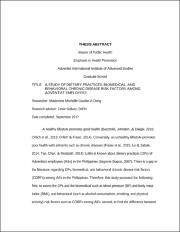A Study of dietary practices, biomedical, and behavioral chronic disease risk factors among Adventist employees
Abstract
A healthy lifestyle promotes good health (Beezhold, Johnston, & Daigle, 2010; Orlich et al., 2013; Orlich & Fraser, 2014). Conversely, an unhealthy lifestyle provokes poor health with ailments such as chronic diseases (Fraser et al., 2015; Le & Sabaté, 2014; Tan, Chan, & Reidpath, 2014). Little is known about dietary practices (DPs) of Adventists employees (AEs) in the Philippines (Segovia-Siapco, 2007). There is a gap in the literature regarding DPs, biomedical, and behavioral chronic disease risk factors (CDRFs) among AEs in the Philippines. Therefore, this study purposed the following: first, to assess the DPs and the biomedical such as blood pressure (BP) and body mass index (BMI), and behavioral (such as alcohol consumption, smoking, and physical activity) risk factors such as CDRFs among AEs; second, to find the difference between
demographic variables (such as gender, age, marital status, educational attainment, and occupation) considering DPs, biomedical, and behavioral CDRFs among AEs; and third, to assess effects of DPs, behavioral, and biomedical CDRFs on biomedical CDRFs.
This was a descriptive-correlational study that used a quantitative approach. The population of the study consisted of AEs working in Adventist institutions in the Central Philippines Union Conference (CPUC), Cebu City, Philippines. The researcher-made Health Habits and Practices Questionnaire (HHPQ) was utilized for data collection and analysis. The HHPQ comprised five different sections—namely, anthropometric measurements, personal information, DPs, physical activity, and other practices. After data collection and analysis, the Cronbach’s alpha of the final instrument was 0.77, which indicates a good reliability of the instrument.
Overall, AEs working in Adventist institutions in CPUC scored average in their DPs (M = 3.28). Although their BMI was within the normal (M = 2.45), their BP was high (M = 1.66). AEs in CPUC were pre-hypertensive. They do not consume alcohol (M = 4.94) and they appear to be non-smokers (M = 4.28); however, their exposure to secondhand smoke was high (M = 3.61). Their physical activity level was found to be below the lowest level of exercise (M = 2.30). Finally, multiple regressions revealed that BMI has no predictors. Furthermore, weight, history of smoking, and consumption of unhealthy beverages were the best predictors of BP (R2 = 0.128).


